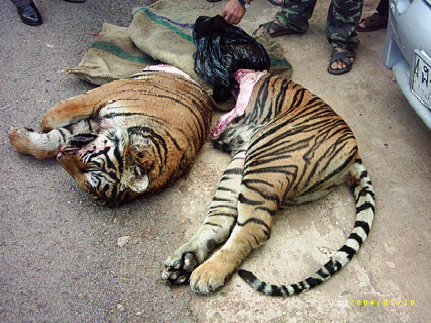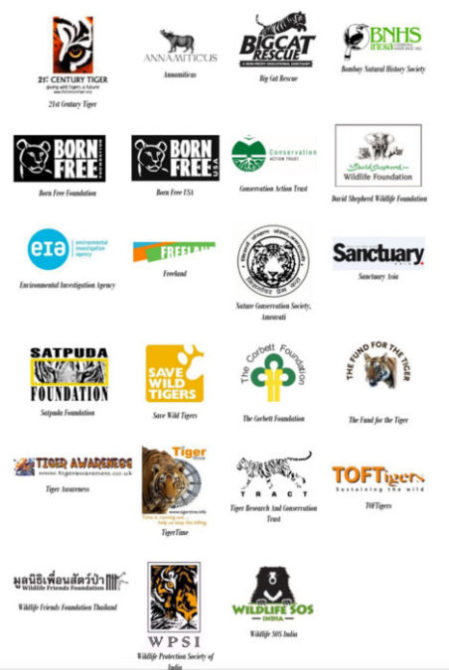Thailand’s Tiger Temple Sues Conservationists Over Abuse Allegations
Tiger Temple is a Sham
Abbot of the Tiger Temple, Pra Acharn Phusit (Chan) Khantitharo caught on film beating tigers with a stick. (Photo courtesy CWI)
Thailand’s Tiger Temple Sues Conservationists Over Abuse Allegations
KANCHANABURI, Thailand, February 3, 2010 (ENS) – Three advocates for wildlife conservation and welfare appeared in a Kanchanaburi court this morning to answer charges of defamation brought by the Tiger Temple, a tourist attraction in Kanchanaburi.
Edwin Wiek, founder and director of Wildlife Friends of Thailand, a wildlife rescue center near Hua Hin, has been charged along with two other conservationists over remarks in an April 2009 article published in the “Thai Post,” a daily Thai-language newspaper. In the report, accusations were made concerning illegal possession of and trade in tigers at the temple, and abuse of the animals.
Monk at the Tiger Temple pulls a tiger by the tail to position it for tourist photos. (Photo courtesy Tiger Temple Truths)
The other two defendants are Sawan Sangbunlang of the Thai Society for the Prevention of Cruelty to Animals and Dr. Surapon Duangkae of the Wildlife Fund Thailand under Royal Patronage. This organization closed in July 2009 due to lack of funds.
If convicted, they could face jail sentences.
Hundreds of foreign tourists daily visit the Tiger Temple to see and take pictures with the tigers. It is a lucrative business. The entrance fee is 500 baht (US$15) per person while making “special photos” costs 1,000 baht (US$30) extra. For a morning experience, people pay 4,500 baht (US$120) per person to feed the cubs and watch the cub exercise session.
The Tiger Temple’s success is based around claims that its tigers were rescued from poachers and live and move freely and peacefully amongst the temple’s monks, who are actively engaged in conservation and rescue work.
However, undercover investigations by the British wildlife charity Care for the Wild International, conducted from 2005-2008, revealed evidence of tigers at the facility being regularly beaten with wooden sticks and clubs, being forced to sit in direct sunshine for hours, and being kept in poor conditions with inadequate food.
The CWI investigators observed that when tigers are not obedient before, during or after the photo-sessions they are sprayed by the keepers with urine from bottles in their eyes and faces and/or hit with wooden sticks on their backs and heads.
Tigers are reported to be extremely lethargic during photo sessions, leading to concerns they may be drugged.
A British tourist, visiting the Tiger Temple on a tourist day trip from Bangkok in December 2009 wrote in an unsigned letter posted on the website Tiger Temple Truths, “The tigers heads were picked up and dropped heavily into our laps for us to pose with, but the tiger I was with didn’t make a sound or move a muscle, it’s like he had no idea where he was, or what was happening to him. … I don’t believe a tiger can sleep so deeply without being sedated in some way.”

This tourist also observed abuse of the animals. “The Tiger Temple Thai staff were on hand to keep the tigers away from us,” she wrote. “They did this by banging the ground and shoving the tigers away with tools such as spades, pickaxes and long metal poles. One Thai temple staff member went to hit the ground in front of one of the tigers with his pickaxe, in order to keep him from coming too close to us, but the pickaxe hit the tiger in the paw instead, and the tiger made a small noise of pain and leapt away to lick his paw.”
Care for the Wild International’s 2008 report “Exploiting the Tiger” uncovered evidence of illegal trade and breeding of tigers at the facility. A copy of a contract was found in 2008 where the Tiger Temple agreed to send tigers to an illegal tiger farm in Laos, signed by the tiger farmer, the abbot of the temple and a member of the temple board.
The CWI report states, “Whilst the Tiger Temple claims it received its first tigers legitimately as animals rescued from poachers, CWI has obtained evidence that, rather than continuing as a rescue centre, the Temple now operates as a breeding facility and is involved in the clandestine exchange of tigers with the owner of a tiger farm in Laos. These actions contravene Thai, Laos and international law (Convention on International Trade in Endangered Species in Wild Fauna and Flora – CITES).”
Breeding tigers in Thailand requires a government license under the Thai Wild Animals Reservation and Protection Act 1992. The temple does not have such a license but has, by its own records, bred at least 10 cubs from its original animals.
To be part of a conservation breeding program, the genetic make-up and history of an animal’s parents must be known. But the original animals at the temple are of unknown origin, nor have they been DNA-tested to identify their sub-species, according to the CWI report. With this background, the temple cannot participate in any recognized conservation breeding program.
Wiek disputes the Tiger Temple’s claims that it can release its tigers back into the wild, because he says the tigers in its care are hybrid animals resulting from the breeding of two different sub-species and have no conservation value.
“All tigers at the Tiger Temple are hybrid tigers that originated from a commercial tiger farm in Ratchburi province. The value to conservation of hybrid wildlife is zero,” Wiek says. “They don’t have any value for conservation because they don’t boost the gene pool and they can’t interbreed with wild tigers.”
“The release of hybrid wildlife back to the wild is considered a biological crime by conservation experts worldwide,” said Wiek in a posting February 2 to an email list about animals in Asia. “In the past years, several tigers from the tiger temple have mysteriously disappeared once mature, and some when there were excess cubs.”
Care for the Wild International says, “There is consensus amongst conservationists that releasing captive-bred tigers is almost never a viable option because of shortage of natural habitat and, in the case of animals that are used to human proximity, such as the tigers at the temple, release is potentially fatal to tigers, humans and livestock.”
Click here to read Care for the Wild’s report, “Exploiting the Tiger: Illegal Trade, Animal Cruelty and Tourists at Risk at the Tiger Temple, An investigation at Wat Pa Luangta Bua Yannasampanno Forest Monastery, Kanchanaburi, Thailand.”
The Tiger Temple

My temple should be a house of prayer
But you have made it a den of thieves*
A few weeks ago at church we had a visit from the bishop, and his homily was based on the reading about Jesus driving the sellers and moneychangers out of the temple. I have always been particularly moved by this passage, as I feel that it has a message far beyond what most people realize. The bishop explained that the moneychangers were there so that the Jewish laws against false gods could be circumvented, thus enabling the market to cheapen the church by turning its doors into a place for buying and selling. You see, the Jews were required to bring gifts for the priests on certain holy days. Because Roman tender referred to the Roman emperor as “divine,” the Jews could not use Roman money to purchase items because the money itself was idolatrous. The moneychangers showed up on the steps of the temple to change out Roman coins for Jewish ones, thus enabling the peddlers to sell their wares to the Jews who needed gifts for their holy ones.
What, you may ask, does this have to do with tigers? This bible story often reminds me of the disturbing image displayed above. I think we humans would do well to expand our view of the “temple.” When we say “temple,” we usually think of buildings dedicated to the worship of a religious deity, or some sort of sanctuary, the meaning of which is often taken literally as a sacred place to which to retreat to escape the demands of the world. How often do we ask ourselves precisely what it is from which we need to escape? From what do we need sanctuary? Perhaps the above image says it all.
I view the entire earth as a temple, teeming with life forms of all kinds, and all of which are sacred. Each one has a position, a role, a unique gift for the entire living system. Its worth is truly measured by its living gifts to the living. Yet we treat these creatures like cheap Roman coins, made to be cut up and exchanged for the things that we wrongly believe are truly valuable. To those who view these magnificent beings as a commodity, they are worth more dead than alive.
Perhaps the most insulting and insidious example of this twisted thinking is the proposal, recently featured by John Stossel on 20/20, that in order to “save” tigers from extinction, we should “farm” them to satisfy the greed of the poachers and those to whom they sell dismembered tiger parts. “Free market economics!” they cry. Once again, someone offers up the tired old myopic view that the market will save us from everything. People are so busy looking through the wrong end of the telescope that they fail to see that the market mentality is the thing that got tigers into this mess in the first place. Talk about worshiping a false god.
I repeatedly marvel at how a group of people can come up with a really, really bad idea, spin it, twist it, sell it, build enormous juggernaut-like institutions around it, and then point to the institutions themselves as proof that the original idea was good and true. Once this happens, it becomes ever more difficult to dismantle the faulty reasoning and resurrect the truth. People begin looking through the lens of the institutions themselves and are blind to everything else. Here I refer to the institution of economics. “If we can keep tigers from going extinct AND satisfy the poachers, what’s the problem here?” they ask. The problem here is that the ideas that drive the poachers are, in a word, wrong. Or, more precisely, they stem from people valuing the wrong things. Or, more precisely, they stem from people valuing ONLY THINGS. Tigers are becoming extinct not because people can’t buy and sell them; they are becoming extinct because we push them out of the way to make room for the things we want to buy and sell.
Does this become a wake-up call? Do we face the inherent problems with the free market? No, we simply turn the free market lens on living creatures, and from there, we come to the faulty conclusion that we can “save them” by paying them the big favor of becoming another one of the things that we want to buy and sell. The market may very well be free, but the tigers most certainly are not. We do not farm tigers to save them from extinction; we farm them so that their parts can be sold for profit. We do not breed them to save them from extinction either; we breed them so that they may be sold as pets and novelty acts. All of these things have been going on for over one hundred years and we are still losing tigers in the wild.
But that’s really it, isn’t it? It’s not so much the tigers that we are losing as it is the “wild” from which they come and to which they really belong – the wild that shaped their contours over the countless millennia, the wild, in whose dominions they earned a place by meeting its challenges over the unfathomable eons, the wild that, in our quest for predictability and comfort, we have ultimately feared and forsaken. The reason the ideas that drive poachers and tiger farmers are wrong is because they reflect that we value the tigers only according to what they can give us, not according to what they really are.
This earthly temple came to us with conditions that we have stubbornly and childishly refused to accept, and as a result we are forcing the tigers and every other wild thing that we cannot understand through the proverbial eye of the needle, the gate that leads to the institutions that we built to serve us but that we now serve, and we make them pay the price – first by forcing them to live in concrete and barbed-wire worlds that are completely foreign to them, and last by handing them over to those who have no regard for anything they might hold dear, like the rivers in which they would swim, the forests in which they would roam, the grass in which they would bask in the sun.
These are the gifts of the wild. These are the gifts of the earthly temple. These are the things that were given freely until WE were the ones that decided they needed to be divided, bought, and sold. The tigers need more than to just be saved from extinction. They need sanctuary – from us. Those of us who value them whole and alive have this to say – it’s time to drive the moneychangers out of the temple. The tigers are not for sale.
Sharyn Beach
*Photo courtesy of Save The Tiger Fund
Tiger (farmed) cut in half by smugglers that were caught by Thai highway police May 2004.
*Tim Rice, Andrew Lloyd Webber. The Temple, from the album “Jesus Christ Superstar,” 1970, Decca Records. Interpretation of Matthew 21:12.






It would appear that this poster on Thaivisa has evidence of illegal movement of Tigers…….although he claims they were in a good cause. He claims many have been shipped to other zoos……..As the tigers at the Temple are of indeterminate DNA, it would seem that any shipment of them would be illegal
according to My LennyW……..
"Another ****** that knows nothing of the place, you have no idea of the work they do re-stocking zoos, safari parks and animal sanctuaries throughout the world, it is very important work in regards to the conservation of the species, no thought not.
I suggest you go volunteer at the place for a few months then you shall be able to post with knowledge instead of ill informed imagination."
https://www.thaivisa.com/forum/topic/691081-tiger-temple/#entry7451633